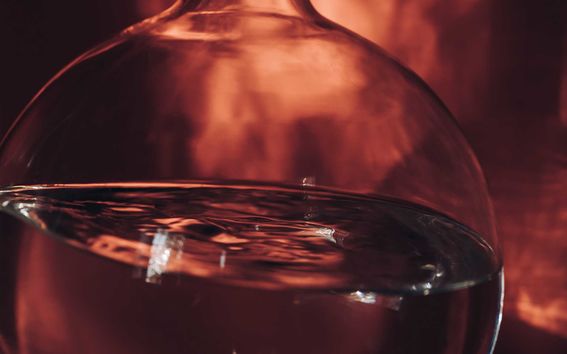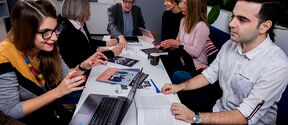Wiser decisions

Some 750 million people around the world lack access to clean drinking water. Many of them live in East Africa, where people typically kill bacteria and viruses in available water by boiling it over charcoal fires. This not only contributes to deforestation and the release of carbon; smoke can also affect human health when fires are lit in poorly ventilated houses. There is a cost consideration too, with many families spending a considerable portion of their income on charcoal.
Nanomaji ('maji' means 'water' in Swahili) is a startup created by Master's students at Aalto University, who have developed a water-purifying solution that works in the local context. Recognising that (unsafe) water is typically collected and carried in jerry cans, the students ― working with Finnish fibre-materials company Ahlström-Munksjö ― designed a carbon-based filtration device that attaches to the mouth of a jerry can. When the jerry can is upended, water flows slowly through the device and becomes safe for drinking.
The project, which won a prize in Europe's largest climate-innovation competition (ClimateLaunchPad), is a prime example of what’s known as frugal innovation: stripping a product down to its essentials to make it affordable.
‘We use the term frugal innovation to talk about reducing the use of energy and materials to make something accessible to people who earn less than five dollars a day,’ says Professor Minna Halme, whohas been working in sustainability management for more than 25 years. Part of her work looks at how poverty alleviation can be addressed through business models that work as a force for change.
‘While teaching executive education in the 2000s, I noticed that managers always became excited when asked to think about innovative solutions to environmental problems that also make commercial sense,’ says Halme. ‘This can be applied in the societal development context too. By designing business models that provide people with products and services they wouldn't otherwise be able to afford, we can do a lot to alleviate poverty.’
Innovation for everyone
Frugal innovation is closely related to another concept that is core to the work of Halme and her research colleagues: reverse innovation. When you innovate to create something with frugal means ― often in a lower-income context ― that innovation can then be brought into higher-income markets too. With sustainability concerns increasingly in the spotlight, the concept is gaining ground around the world.

One of the best-known examples of reverse innovation is a line of electrocardiogram (ECG) systems first developed for the Indian market by GE Healthcare ― a leader in ECG equipment. An ECG is the most common cardiac test, but the equipment for it is traditionally expensive. This was until GE engineers in India developed the company's MAC 400, a portable and battery-powered machine with two-button operation that simplifies training and use. The MAC 400 cost hundreds of dollars instead of thousands, which turned out to be a compelling proposition for markets in Europe, the US and elsewhere as well. Today, GE Healthcare's MAC products are available across the world.
Reverse innovation is core to the New Global research project that Halme leads. Backed by the Finnish Funding Agency for Innovation, the project has supported Halme’s colleague Professor Peter Lund in a solar electricity initiative for rural India. Lund and his team worked with local company Boond Engineering to create a smart-metering solution that helps village dwellers manage their consumption of solar-generated electricity.
‘When the pico-, micro- and mini-grids of rural villages rely on solar power, the network collapses if too many households use electricity at the same time,’ says Halme. ‘Smart metering addresses this by adjusting the price of electricity according to demand.’
‘The solution we developed with Boond presents variable electricity prices in colour codes that are easy for illiterate people to understand, so they can save money by reducing their consumption at peak times. This, in turn, means grid overloads can be avoided.’
‘These types of decentralised energy solutions and smart metering are very relevant for the future of energy provision in many parts of the world, including in developed countries,’ says Halme.
Design for transition
The transition to future energy models is central to the work of Professor Sampsa Hyysalo. His research team has been using the principles of co-design to bring multiple stakeholders together to build the roadmap for Finland's shift to a clean-energy future.
Sampsa HyysaloFor climate change mitigation, the rubber must meet the road by 2030.
‘Co-design is about devising and researching arrangements by which different stakeholders can effectively collaborate,’ says Hyysalo. ‘The methodology is not only used in product and service design, but increasingly also in broader social reforms. It's about how we can reach wiser decisions by tapping into the competency pools of a wide range of stakeholders.’
To plan Finland's energy transition up until 2030 ― the year by which many measures that limit global temperature rises need to be in place ― the researchers brought together 23 people from across society. The group included members of parliament, officials from four government ministries, mayors from carbon-neutral cities and municipalities, business leaders from energy companies, representatives from NGOs, and energy-active citizens.
Hyysalo had originally planned to use a transition-management approach developed by Dutch researchers. But this method focuses on implementing change over longer timescales of between 40 and 100 years, whereas the transition in Finland needs to be much quicker. So Hyysalo's team developed their own approach, broadly re-designing the transition management process.
‘For climate change mitigation, the rubber must meet the road by 2030,’ he says. ‘The hard decisions need to be made by then if we're ever going to meet our longer-range climate change targets.’
Walking the same path
The researchers developed a new kind of mid-range planning process, and then ran a year-long workshop series with a meeting approximately every six weeks. The participants articulated goals for eight transition paths up to 2030, and then together planned the steps needed to meet the goals. They defined and agreed upon concrete actions in regulation, business, investment, consumer behaviour, energy production and more.
‘What society can do in reaching wiser decisions is create ways for people to directly negotiate with each other,’ says Hyysalo. ‘This is very different to traditional forums, such as hearing procedures and roundtables, in which each stakeholder is prone to defending their own interests.’
‘Co-design principles can help us to get beyond the political cycle of elections, and move away from stop-start planning. We need a degree of permanency in these long transition projects, such as those related to energy and resource use. These are issues that will not be solved by any one government alone.’
‘What a small country like Finland can do is set an example to the rest of the world on how to run these kinds of important societal processes on a more democratic footing,’ says Hyysalo. ‘Even extremely tough subjects can benefit from broadening the group making a decision, rather than leaving it to a narrow group of elites.’
Text: Andrew Flowers
From clean energy to personalized medicine – a book about the power of the university
The Aalto Effect is a tribute to the ambitious and uncompromising work of dozens of researchers.

Read more news

Research Council of Finland establishes a Center of Excellence in Quantum Materials
The Centre, called QMAT, creates new materials to power the quantum technology of coming decades.
Two Unite! Seed Fund projects involving Aalto secure top EU funding
Two prestigious EU grants have been awarded to projects that were initially supported with Unite! Seed Funding. Both projects involve Aalto.
Major funding powers development of next-generation machine technology aimed at productivity leap in export sectors
The BEST research project is developing new types of sealing, bearing, and damping technology.






